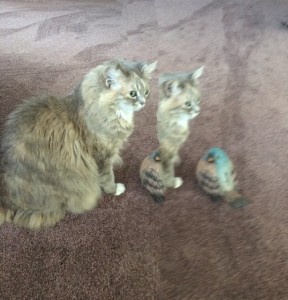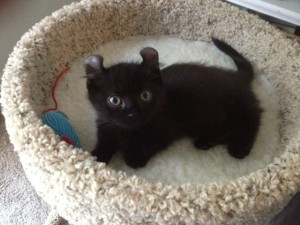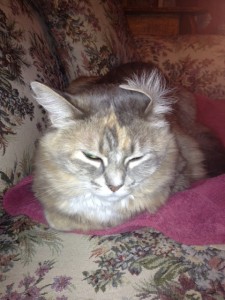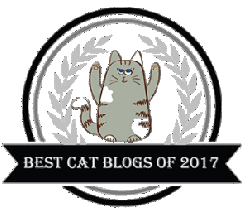 Ever hear of a Munchkin, an American Wirehair, or a Twisty Cat? Surely, you’re familiar with the Scottish Fold and the Manx. These are all cats stemming from mutations. At some point, a breeder got an unexpected peke-faced Persian or a tail-less kitten or one with six toes, for example, and decides to breed for this deformity. Why?
Ever hear of a Munchkin, an American Wirehair, or a Twisty Cat? Surely, you’re familiar with the Scottish Fold and the Manx. These are all cats stemming from mutations. At some point, a breeder got an unexpected peke-faced Persian or a tail-less kitten or one with six toes, for example, and decides to breed for this deformity. Why?
There’s a market for designer cats. They’re something different. And people will pay big bucks for something different—sometimes without even understanding how the deformity affects the cat’s health and well being.
I remember the first time I saw the Ragdoll cat. It was at a cat show. There’s a rule at cat  shows. You do not touch the cats. However, this time, as I admired a large buff and brown cat, the owner held him out to me and said, “Here, want to hold him?” Of course, I did. And I was told that day that the Ragdoll, known for its large size and floppy, relaxed nature, is an accidental mutation. I was told that a pregnant white cat was hit by a car and when she delivered, the kittens were very calm and quiet. Some say this cat feels less pain than most. This is a fairly new breed, having been started in the 1960s.
shows. You do not touch the cats. However, this time, as I admired a large buff and brown cat, the owner held him out to me and said, “Here, want to hold him?” Of course, I did. And I was told that day that the Ragdoll, known for its large size and floppy, relaxed nature, is an accidental mutation. I was told that a pregnant white cat was hit by a car and when she delivered, the kittens were very calm and quiet. Some say this cat feels less pain than most. This is a fairly new breed, having been started in the 1960s.
Peke-faced cats were first bred in the 1930s, the Scottish Fold, in 1961, and the Sphynx in 1966. Many designer cats have health or physical issues. The Peke-faced cats have problems with breathing, as well as with their eyes and teeth, for example. The Scottish Fold is more susceptible to ear mites and deafness, plus they cannot use their ears to communicate mood as other cats can. Hairless cats must be cared for differently because they have no defense against the cold. The Twisty Cats are thought to have all sorts of problems—they can’t knead on the mother cat to get milk, they can’t scratch to keep their claws healthy, and some can’t escape danger like a normal cat. Some say the Munchkin is prone to a variety of health issues due to the length of the spine and the set of the legs.
 Sure, kittens are sometimes born with a deformity—deafness, blindness, crooked tail, or diminutive size, for example. And we just take care of it in the best way we can. Just scour the Internet and you’ll find cats with an extra set of ears, cranial abnormalities, two faces and more, but this doesn’t mean that we should capitalize on the defect by trying to breed for more such kittens.
Sure, kittens are sometimes born with a deformity—deafness, blindness, crooked tail, or diminutive size, for example. And we just take care of it in the best way we can. Just scour the Internet and you’ll find cats with an extra set of ears, cranial abnormalities, two faces and more, but this doesn’t mean that we should capitalize on the defect by trying to breed for more such kittens.
Some of these designer cats have actually made it into the various cat registries and some have not. Sometimes all it takes is many years of perfecting the abnormality in order for it to become a recognized breed. “Perfect the abnormality.” Is that an oxymoron?
Our Lily has very soft ears. I’ve never known a cat with such flexible ears. Often, when she washes her face and cleans her ears, the ear will fold back and stay that way until she fixes it or I gently fold it back. (See photo) I guess (before I had her spayed) I could have found a male with “bendy” ears and started a breeding program to capitalize on this odd distortion. Lily could have been the mother of all “Bendy-eared Cats” or “Flex-ear Cats” or maybe “Gumby-ear Cats.”
How do you feel about breeding to change the cat? I once knew a woman who knew nothing about being a breeder or about breeding cats, but she had a particularly small cat and decided to breed her with other small cats and try to come up with the eternal kitten. I lost track of her, so I don’t know if she hit her goal. But guess what, there are now Teacup Persians, Toy cats, and Pocket Cats. And they are adorable. But do you want to support the irresponsible breeding of cats or any breeding of cats, when there are so many homeless cats waiting for a good home and who would make wonderful pets?





